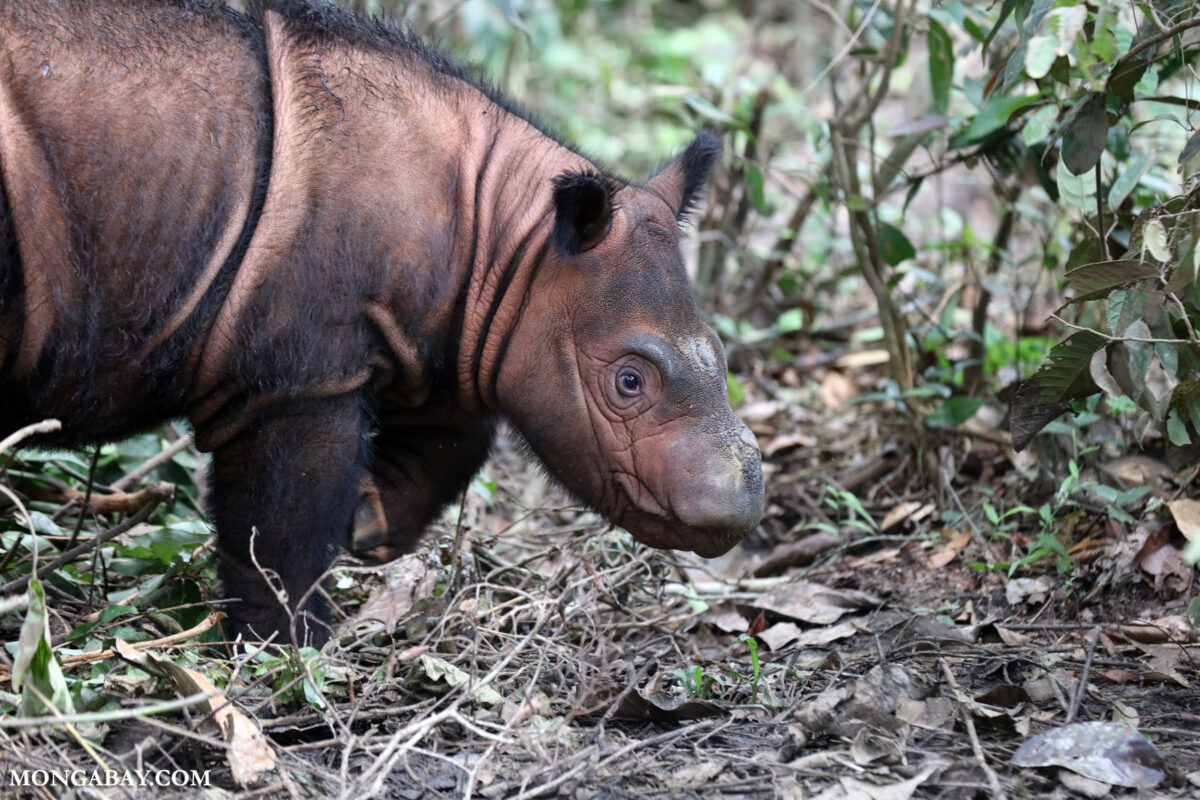- Conservationists and experts had thought Sumatran rhinos extinct in Way Kambas National Park in southern Sumatra.
- But dogs from the NGO Working Dogs for Conservation have detected what’s believed to be several specimens of rhino scat in the park.
- If confirmed, this could lead to deploying dogs in other parks where the critically endangered rhinos may still be hiding out.
Sumatran rhinos — hairy and noisy — were thought to have gone extinct from southern Sumatra for years. Then came the dogs.
Recently, dogs with Working Dogs for Conservation have discovered what are believed to be several heaps of Sumatran rhino dung in Way Kambas National Park, located in the southern part of the Indonesian island. The scat has undergone one test to confirm it was deposited by a Sumatran rhino (Dicerorhinus sumatrensis); two tests remain until the Indonesian government is certain. Still, conservationists are cautiously optimistic.
Nina Fascione, executive director of the International Rhino Foundation (IRF), says she would have bet her paycheck that there were no rhinos left in Way Kambas.
“You can’t prove a negative,” she says, but she advocated for the dogs to prove that no more resources should be used in the park for rhinos. They’d tried everything to locate any remaining rhinos in Way Kambas, she says: the government, the local NGO YABI, and IRF had deployed rangers searching for rhinos, camera traps and drones for years — nothing.
“[So], let’s get dogs in there. We’ll say we’ve tried everything,” Fascione says.
After years of searching, it took the dogs, named Yagi and Quinn, just two days to find the scat.
“I was nothing short of thrilled,” says Pete Coppolillo, executive director of Working Dogs for Conservation. “With fewer than 50 [Sumatran rhinos] in the entire global population, even a single individual is a big deal.”
Coppolillo says the dogs are trained for three to four months, but after that they can “learn a new target in an afternoon.” Still, the team trains the dogs for several weeks on its new target, using every type possible: male, female, juvenile. The dogs were trained on scat from 10 captive rhinos at the Way Kambas Rhino Sanctuary.

The biggest challenge was working in a rainforest, Coppolillo says.
“In tropical forest we have to watch for infections and fungus, but at the same time keep [the dogs] cool, which often means wet, so it requires constant vigilance and care,” he says. He adds that conservation dogs work best finding animals that occur at low densities, are secretive, and dwell in “structurally complex landscapes.” Sumatran rhinos fit all of these.
The teams are cautiously optimistic the scat will pass the two more tests.
“Quite honestly, in my opinion, I trust the dogs,” Fascione says. “The dogs were trained on rhino’s scat. They found what everybody believes is rhino’s scat. We think it’s really good news.”
Sumatran rhinos are one of the most threatened animals on the planet. A new report by the IUCN, the global wildlife conservation authority, estimates the total wild population is only 34-47 animals. The species is also famously elusive, with rangers saying they’ve even learned to avoid camera traps.
“I feel greedy saying it, but I’m hoping there’s more than one rhino [in Way Kambas]. Can you imagine if we confirm breeding? This is the stuff we conservationists live for!” Coppolillo says.
Fascione says any rhino found in Way Kambas should be captured for the breeding program, which desperately needs new genes, especially from males.
“I’ve never been happier to be wrong about something in my life if I indeed am wrong,” she says, adding, “There are clearly some very reclusive rhinos hanging out. My hope is that there are more of those rhinos in more places than we know of.”
Another park in southern Sumatra, Bukit Barisan Selatan, had rhinos until recently. Perhaps the dogs could find a lost population there too?

Banner image: A baby Sumatran rhino in Lampung. Image by Rhett A. Butler/Mongabay.
Javan rhino numbers plunge; Sumatran rhinos remain near extinction: Report
Source link
#Sniffer #dogs #rediscovered #lost #population #Sumatran #rhinos
